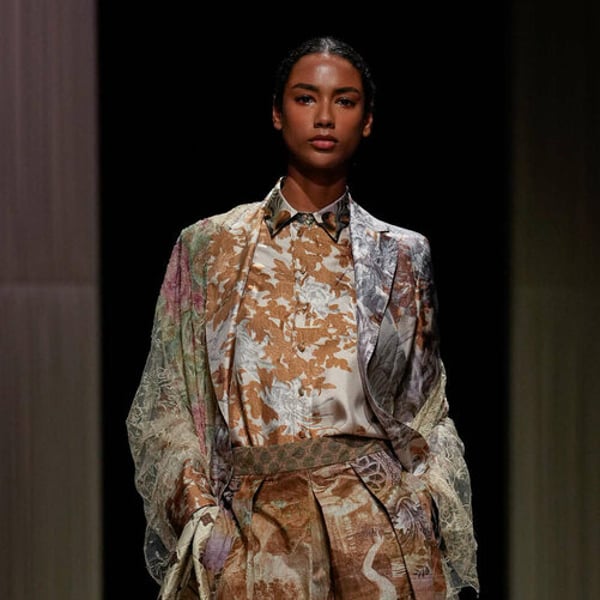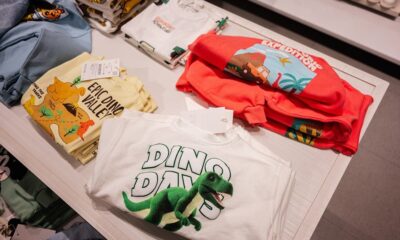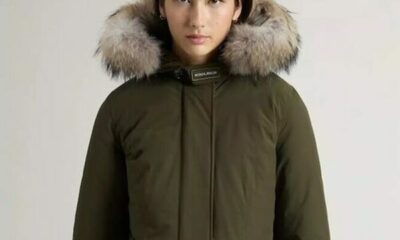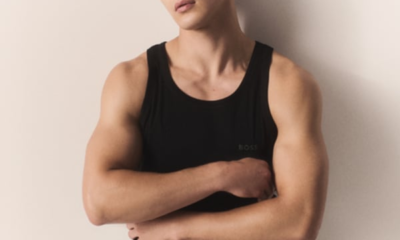Fashion
Milan: An invitation to journey with Calcaterra, J. Salinas and Pierre-Louis Mascia

Published
September 28, 2025
After the rain that spoiled part of fashion week, the final day of Milan’s in-person catwalk shows drew to a close in style beneath an azure sky on Sunday. Before the much-anticipated Giorgio Armani show that rounded off the day, several collections stood out for their creative richness, each designer immersing onlookers in a distinct world, from Calcaterra’s Berber-accented fashion to the virtuoso knitwear crafted by Peruvian artisans for J.Salinas, via the cinematic and 18th-century inspirations of Pierre-Louis Mascia.
Yves Montand’s warm voice humming “Les Feuilles Mortes” opened Pierre-Louis Mascia’s enchanting show; he is unrivalled in conjuring a poetic atmosphere steeped in nostalgia. For his new collection, the Toulouse-born designer drew inspiration from his favourite film, Marcel Carné’s “Les Enfants du Paradis”.
“The setting is a theatre, and the theme revolves around impossible love affairs. This black-and-white film, shot during the war, sets the tone for the collection with faded, dusty, sun-bleached hues, into which colour gradually seeps,” he explained.
Another source of inspiration is the 18th-century fabrics and silk jacquards of court dresses held in the archives of the Musée Galliera, to which Mascia gained access as part of a partnership between the label and the Paris institution, to be announced next March.
These two strands culminated in a refined, supremely elegant collection, with silk taking the lead in shimmering, fluid pieces. The light, comfortable garments featured very few fastenings and eschewed superfluous details. Front and centre were Mascia’s drawings and illustrations, including twenty-one new original prints in which diverse themes collide in finely calibrated balance.
Landscapes in India ink, foliage, toile de Jouy, animal prints, tapestry effects, abstract or geometric motifs, and paisley all come together harmoniously in precious silhouettes. A little silk robe-style coat slipped, revealing a shoulder. Blouses matched skirts in the same tones, while their prints evoked imaginary, melancholy tales.
Blouses and slip dresses were cut from finely fringed shawls. Delicate tunics fell to the knee over trousers tied at the ankle, at times recalling saris. Lightweight overcoats whirled above shirts and skirts fashioned from silky fabrics. Backed by his partner, the Como silk printer Achille Pinto, Mascia also offered this season a breathtaking series of silk pieces that perfectly simulate denim. Since he began showing, his visibility has grown. For 2025, revenue is expected to rise by 15%.
For Spring/Summer 2026, Daniele Calcaterra conceived a journey through time and cultures, leaping between the twenties, forties and nineties, with a detour via the Sahara. The collection oscillated between austere, masculine rigour and sensuous, free-flowing femininity.
On one side, there were trench coats, overcoats and, above all, suits with wide-lapel jackets, oversized men’s waistcoats and generously cut trousers with rounded lines, whose volume imbued women with power. This comfortable, practical wardrobe was conceived for everyday life, featuring, among other pieces, two-tone jeans, the classic striped shirt elongated into a tunic at the back, a slit pencil skirt and a chic suit with a swirling skirt.
On the other, the wardrobe turned more lustrous and fluid, with long fringed silk dresses that caressed the body, cloud-like tops punctuated with ostrich feathers or formed from series of fine fringes in differing lengths, and sheer organza looks. Scarves were worked into outfits to lend an airy touch, whether in skirts or T-shirts. They were sometimes draped over the shoulders like little capes, or tied around the neck.
Ethnic details ran throughout, such as Berber jewellery and belts edging the collars and cuffs of certain blouses.
For his second Milan show, J.Salinas enlisted the services of stylist Anna Dello Russo. Designer Jorge Luis Salinas, determined to win over the European market, pulled out all the stops, staging his show in an elegant, sun-drenched city-centre garden.
Ever focused on knitwear, the Peruvian couturier—who deploys countless knitting techniques to crochet sinuous mermaid dresses in a multitude of stitches—broadened his offer this season with more wearable pieces designed for a Western clientele. These include mini dresses, miniskirts, shorts, flared trousers, jackets and cropped tops with ruffled shoulders, tied at the back with long knitted ribbons.
The collection was presented in a pastel palette of dragée pink, sage green, sky blue and tangerine, spotlighting Peruvian craftsmanship. Each piece was knitted in Pima cotton by local craftswomen, then assembled to create openwork garments composed of a cascade of motifs (roses, flowers, raised polka dots, feathers, shells, and scales), layers of doilies and other lace which, arranged in garlands, traced curves and whorls around the body.
Salinas collaborates with communities of craftswomen across the country—around fifty knitters who enrich his work, each bringing her own ideas and skills. Seven of them were present in Milan on Sunday. They came to greet the public in their traditional dress to a round of applause.
This article is an automatic translation.
Click here to read the original article.
Copyright © 2025 FashionNetwork.com All rights reserved.
Fashion
Shoe Carnival to rebrand as Shoe Station Group

Published
November 13, 2025
Footwear and accessories retailer Shoe Carnival, Inc. announced on Thursday plans to change its corporate name to Shoe Station Group, Inc., reflecting a strategic shift toward unifying its retail operations under a single banner.
The company expects over 90 percent of its store fleet to operate as Shoe Station by the end of fiscal 2028, with the remainder to be evaluated for rebannering, outlet repositioning, or closure. Having completed 100 store conversions in fiscal 2025, the retailer anticipates that more than half of its stores will operate under the Shoe Station name by the back-to-school season in 2026.
“Today marks a pivotal moment for our company. Shoe Station is winning – growing comps, expanding margins and capturing new customers,” said Mark Worden, president and chief executive officer.
“The board of directors’ decision to approve the corporate name change to Shoe Station Group reflects our confidence in this banner’s potential and establishes our foundation for becoming the nation’s leading family footwear retailer.”
Preliminary third-quarter results highlight the brand’s momentum. Shoe Station posted a 5.3 percent increase in net sales, while the legacy Shoe Carnival banner saw a 5.2 percent sales decline, attributed to continued pressure on lower-income consumers. Overall net sales during the quarter reached $297.2 million, and diluted earnings per share came in at $0.53.
As part of the change, the retailer anticipates approximately $20 million in annual cost savings by the end of fiscal 2027, while inventory investment is expected to decrease by 20–25 percent.
“We are building a simpler, more efficient company with one team, one infrastructure, and one P&L that is expected to generate millions in annual cost savings, sharply reduce our inventory investment, and create a balance sheet built for both organic growth and strategic acquisitions,” added Worden.
Shoe Carnival is expected to report its full third-quarter financial results on Thursday, November 20.
Copyright © 2025 FashionNetwork.com All rights reserved.
Fashion
Elisabetta Franchi reports €171 million revenue in 2024, sees accessories as growth driver

Translated by
Nicola Mira
Published
November 13, 2025
Elisabetta Franchi, boss and designer of the eponymous Italian ready-to-wear label owned by Betty Blue Spa, talked about the industry at the 30th Pambianco Fashion Summit in Milan. “There’s so much confusion in the fashion world today,” she said. “Creative directors are hopping about like popcorn. Labels are putting their brand identity at risk. When customers enter a store, they no longer know what they’re buying. Some CEOs have no clue what a button or a sewing machine is. They are finance people who have only eyes for data,” added Franchi.
The Bologna-based businesswoman has taken back control of her label after parting ways with Marco Bizzarri (who had bought a stake about two years ago) and the departure of its CEO Gabriele Maggio. “Marco and I are like twins separated at birth. We’ve always had a very similar way of thinking. But at some point, the Betty Blue machine was starting to slow down. His way of working was no longer in sync with my reactivity. I took back full control to drive the company at a thousand miles per hour. Speed is my strength,” said Franchi.
In fiscal 2024, Elisabetta Franchi generated a revenue of €171 million, and EBITDA of €40 million. “Revenue is not the key. I’m not competing with anyone. I try to work properly, with an old-fashioned approach. A healthy company must be liquid. In the last decade, we’ve doubled [our revenue] and we’ve always self-financed, without bank loans. EBITDA is the metric to watch, if it’s low, I’ve done badly,” said Franchi.
Elisabetta Franchi generates 90% of sales through ready-to-wear, without product licenses (except for childrenswear) or accessories. “These are the growth drivers we’re working on,” said Franchi. “I’ve always pushed to realise one dream, with great consistency and true, powerful storytelling. Women who come into my stores always enjoy the same experience. Some labels decided to increase prices because they were no longer growing. Instead, we’ve made no changes, thanks also to our strategic positioning,” she added.
Retail-wise, in 2025 Elisabetta Franchi opened its first US store in Miami. “In February 2026, it will be Houston’s turn. The USA is very rewarding, but one must work slowly and sensibly there. We also have South America in our sights. E-tail accounts for a 14% share of our revenue, and we don’t just sell t-shirts online, but jackets and shirts too,” said Franchi.
For the future, “I see a company that can do without me, but I’ll be working to the very last. In five years I see myself far away, maybe on my own. Fashion is a business that makes you question yourself every six months. I’m lucky to have a winning team, otherwise I wouldn’t still be here after 30 years,” concluded Franchi.
Copyright © 2025 FashionNetwork.com All rights reserved.
Fashion
Thailand’s apparel exports rise 6.28% in Jan–Aug 2025

Thailand’s apparel exports increased 6.28 per cent to $1.59 billion in January–August 2025, supported by improved global demand and product diversification.
Knitted garments accounted for nearly 65 per cent of total exports, while woven garments also grew.
Innerwear and T-shirts remained top categories.
The growth follows an 8.53 per cent rise in apparel exports in 2024.
Source link
-

 Business1 week ago
Business1 week agoGST rationalisation impact: Higher RBI dividend expected to offset revenue shortfall; CareEdge flags tax pressure – The Times of India
-

 Tech1 week ago
Tech1 week agoBlood Tests for Alzheimer’s Are Here
-

 Sports1 week ago
Sports1 week agoPeat wows in debut as Arizona beats No. 3 Florida
-

 Business1 week ago
Business1 week agoSetback for expatriates? Delhi HC upholds mandatory EPFO membership; what this means for foreign staff – The Times of India
-

 Fashion1 week ago
Fashion1 week agoBangladesh Bank allows foreign currency-taka swap facility for dealers
-

 Politics1 week ago
Politics1 week agoTrump links Republicans’ election setbacks to record US govt shutdown
-

 Tech1 week ago
Tech1 week agoThe AI Data Center Boom Is Warping the US Economy
-

 Tech1 week ago
Tech1 week agoZohran Mamdani Just Inherited the NYPD Surveillance State



















